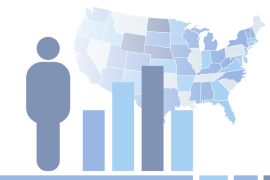American Community Survey (ACS)
The ACS is comprised of two different data files:
- ACS 1-Year Estimates
- ACS 5-Year Estimates
In previous years (through the 2013) there was a 3-Year Estimates but that was dropped in the 2012-2014 ACS and all subsequent years.
Prior to 2010 the US Census Bureau (USCB) released a data file called Summary File 3 (SF3) or “Long Form”. That is no longer the case, instead they release the American Community Survey. The ACS is a continually running survey, released annually. But, in order to collect enough data so as to model meaningful and valid statistics about small locations the USCB has agglomerated data from multiple years into a single set of results. We use the shorthand of calling the ACS by the last year included instead of the 5 year span. Thus the ACS 2021 is really all of the surveys the USCB collected from January 1st 2017 through December 31st 2021 merged into a single set of results.
Advantages of each year of the ACS.
The methodology and variables are almost identical between the 2009, 2010 and the 2011 data files. The difference is the geographic boundaries.
- 2009 ACS is still in the 2000 boundaries which makes it ideal when comparing it to the 2000 Long Form.
- 2010 ACS (and all subsequent years) are in the 2010 boundaries (as established with the 2010 Redistricting)
- 2011 ACS (and subsequent years) has added the Zip Code Tabulation Area as a geography for which you can access 5-year estimates
- 2012 ACS and subsequent years are essentially the same as the 2011 version except that each year a few new tables are added. And of course, the oldest year of data gets dropped and replaced with a new year instead.
- The Geographic Differences Between the Different Durations of the Estimates
2013 ACS is the last year to include the 3-year estimates - 2019 ACS is the last year set in the 2010 boundaries so you could use it to compare data from the 2010 (or 2011) ACS and get nearly a decades worth of data in the exact same boundary definitions
- 2020 ACS is in the new 2020 boundaries, as are subsequent years
The Geographic Differences Between the Different Durations of the Estimates
The 1-year estimates have data just from the survey year and are available for geographic areas with populations of 65,000 or more.
The ACS 3-year estimates were released for geographic areas with populations of 20,000 or more and were collected over 3 years from January two years prior to the survey year through December of the survey year. For example for the 2010 ACS 3-year estimates they will run from January 2008 – December 2010. Only the 2009, 2010, 2011, 2012, and 2013 surveys have 3-Year estimates.
Using the ACS 5-year estimates you can analyze small areas (with a population less than 20,000) such as Block Groups and Tracts (and starting with 2011 the zip code). The problem is that it took 5 years of surveying 2 million people a year to accumulate a large enough sample to provide estimates with accuracy similar to the decennial census. This data file will include data collected starting in January five years prior to the survey year and running for 5 years through December of the survey year (using 2015 as the example January 2011 – December 2015). The data does not show information for individual years but rather only a single number for the average of the area for the 5 years.




